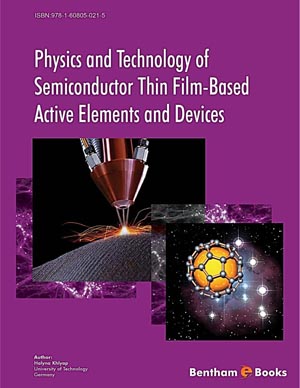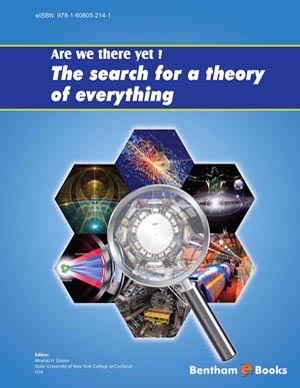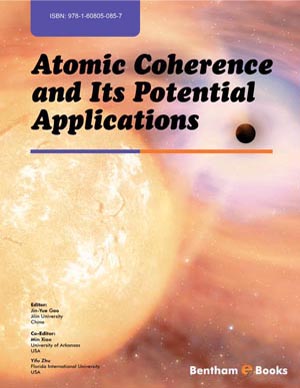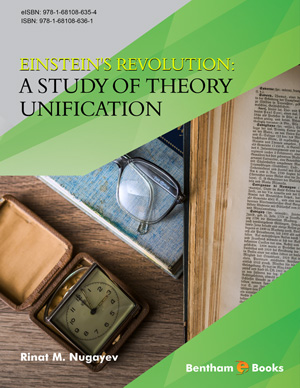Semiconductor Structures: Basic Models and Experimental Results
Page: 1-20 (20)
Author: Halyna Khlyap
DOI: 10.2174/978160805021510901010001
PDF Price: $15
Abstract
Principal theoretical models of nonideal semiconductor heterostructures as well as their applications for describing experimental data are presented. Main electrophysical characteristics (current-voltage and capacitance-voltage) of real heterojunctions based on A2B6-A4B6 materials and nanoheterostructures Si/CNT are interpreted in the framework of these models.
Heterostructure Growth
Page: 21-32 (12)
Author: Halyna Khlyap
DOI: 10.2174/978160805021510901010021
PDF Price: $15
Abstract
Principal technologies used for heterostructures growth are described: molecular beam epitaxy (MBE), metalorganic chemical vapor deposition (MOCVD), atomic layer deposition (ALD). The main tools for characterization of the structures obtained are presented along with recent experimental data on the most important structural and electrical properties of the heterostructures based on III-V and II-VI semiconductor materials.
Investigation of Electrical Properties of Active Elements Based on Silicon and A2B6-A4B6 Group Materials
Page: 33-51 (19)
Author: Halyna Khlyap
DOI: 10.2174/978160805021510901010033
PDF Price: $15
Abstract
Charge transport mechanisms and photosensitivity of amorhous silicon thin films prepared by magnetron sputtering are investigated at room temperature. The power law and the power-exponential laws governing the currents observed experimentally are revealed. The near-IR photosensitivity of the films can be sufficiently improved by means of high-temperature hydrogenation. Important properties of heterostructures based on PbS, ZnSe, ZnTe and CdTe semiconductors are also discussed along with the results of numerical analysis of experimental data.
Engineering of Semiconductor-Based Active Elements by Mechanical Deformation and Ion Implantation Technology
Page: 52-62 (11)
Author: Halyna Khlyap
DOI: 10.2174/978160805021510901010052
PDF Price: $15
Abstract
Effect of external electric field on formation of stressed interfaces in heterostructures grown by molecular beam epitaxy is considered. Ion implantation technology and mechanically induced deformations are appeared to be effective tools applied to manufacture semiconductor-based active elements. Indentation seems to be an important instrument for preparing barrier structures with unique charge carriers transport properties. Ion implantation technique makes it possible to form additional junctions in the implanted crystal matrix which are very important for the increase of efficiency of conventional solar cells.
New Narrow-gap Semiconductor ZnCdHgTe: Growth Technology and Principal Features of ZnCdHgTe-Based Structures
Page: 63-77 (15)
Author: Halyna Khlyap
DOI: 10.2174/978160805021510901010063
PDF Price: $15
Abstract
Preparation and main electrophysical characteristics of narrow-gap semiconductor ZnCdHgTe thin films are described. Experimental room-temperature current-voltage and capacitance-voltage dependences are presented. Energy band diagram construction procedure and results of the numerical simulation of experimental data are also discussed.
Electric Field-Induced Characteristics of ZnCdHgTe Films Surface
Page: 78-86 (9)
Author: Halyna Khlyap
DOI: 10.2174/978160805021510901010078
PDF Price: $15
Abstract
Charge transport mechanisms and photosensitivity of ZnCdHgTe thin films manufactured by liquid-phase epitaxy and laser technology are investigated at room temperature. Laser beam-induced formation of barrier structures is also considered. Effect of hydrogenation as a tool for enhancing device properties of the films is described.
Chalcogenide Semiconductors for Sensor Applications
Page: 87-95 (9)
Author: Halyna Khlyap
DOI: 10.2174/978160805021510901010087
PDF Price: $15
Abstract
Chalcogenide semiconductors A1B5C6 are perspective materials for various sensor applications. The chapter summarizes unique experimental results on electrical properties of Ag3SbS3 monocrystals and provides necessary data for manufacture of γ-radiation sensors based on these materials.
Design of Active Elements Based on Nanostructural A1B5C6 Materials
Page: 96-108 (13)
Author: Halyna Khlyap
DOI: 10.2174/978160805021510901010096
PDF Price: $15
Abstract
Preparation and main electrophysical characteristics of A1B5C6 nanostructural semiconductor materials are discussed. Sensor devices designed for external electric field detection and operation in aggressive environments are described. Numerical simulation of the main electrical characteristics of these structures is also reported.
Outlook-Recent Achievments in Design of Semicoductor Materials-Based Nanoelectronics
Page: 109-125 (17)
Author: Halyna Khlyap
DOI: 10.2174/978160805021510901010109
PDF Price: $15
Abstract
This chapter describes novel applications of composite semiconductors for spintronics and new materials for nanoscale sensors.
Abstract
Full text available.
Abstract
Full text available.
Introduction
This well organized reference book covers the newest and most important practically applicable results in thin film-based semiconductor (A2B6-A4B6 and chalcogenide) sensors, heterojunction-based active elements and other devices. This book is written for researchers, material scientists and advanced students who wish to increase their familiarity with different topics of novel semiconductor material science related to production of thin film-based sensors and active elements for micro- and nanoelectronics. It is also a tool and resource for professionals engaged in novel semiconductor materials technologies. Both basic and applied aspects of semiconductor materials science and technology related to A2B6-A4B6 and chalcogenide compounds, in particular, to ZnCdHgTe semiconductor, are presented in this book. The book features the most important original results in studies and practical applications of A2B6-A4B6 and chalcogenide semiconductor compounds for sensory and micro(nano)electronics. Many important original experimental data as well as results of numerical simulations are included.








.jpg)




